Abstract
Purpose
Central venous catheter placement is useful but is associated with complications. Inadvertent subclavian artery (SCA) puncture is a rare complication associated with internal jugular vein (IJV) catheterization. We determined the position of the SCA by ultrasonography, and propose a needle-insertion position for avoiding inadvertent SCA puncture.
Methods
We positioned an ultrasound probe at an angle of 60° to the skin to mimic a puncture needle halfway between the clavicle and the angle of the mandible (center) and moved the probe parallel to the right IJV (RIJV) toward the clavicle until locating the SCA. We measured the distance from the clavicle to the probe 60 and from the probe to the SCA (P60–SCA) where the SCA was visible by ultrasonography.
Results
For 50 volunteers with a mean age of 27.3 years, the center position was, on average, 67 mm from the clavicle. The image of the SCA appeared within 65 mm of the clavicle. P60–SCA differed significantly between men and women (p = 0.0058). For 45 volunteers, P60–SCA was <25 mm with the probe 65 mm from the clavicle on the skin. RIJVP–SCA averaged 4.4 mm. Only P60–SCA correlated well with BMI for men (r = 0.732, p = 0.0068).
Conclusion
Puncturing the RIJV away from the center should avoid SCA puncture; puncturing it while approaching the clavicle is more dangerous. The exact location of the SCA varies from person to person; thus, confirming SCA position by ultrasonography is recommended every time before puncturing.




Similar content being viewed by others
References
Gamulin Z, Brückner JC, Forster A, Simonet F, Rouge JC. Multiple complications after internal jugular vein catheterisation. Anaesthesia. 1986;41:408–12.
Huddy SP, McEwan A, Sabbat J, Parker DJ. Giant false aneurysm of the subclavian artery. An unusual complication of internal jugular venous cannulation. Anaesthesia. 1989;44:588–9.
Powell H, Beechey AP. Internal jugular catheterisation. Case report of a potentially fatal hazard. Anaesthesia. 1990;45:458–9.
Kulvatunyou N, Heard SO, Bankey PE. A subclavian artery injury, secondary to internal jugular vein cannulation, is a predictable right-sided phenomenon. Anesth Analg. 2002;95:564–6.
Kim J, Ahn W, Bahk JH. Hemomediastinum resulting from subclavian artery laceration during internal jugular catheterization. Anesth Analg. 2003;97:1257–9.
Choi HJ, Kang BS. An uncommon arteriovenous fistula resulting from haemodialysis catheterization despite applying ultrasound guidance: malposition of catheter into right subclavian artery. Hong Kong J Emerg Med. 2011;18:166–8.
Choi JI, Cho SG, Yi JH, Han SW, Kim HJ. Unintended cannulation of the subclavian artery in a 65-year-old-female for temporary hemodialysis vascular access: management and prevention. J Korean Med Sci. 2012;27:1265–8.
Silberzweig JE, Mitty HA. Central venous access: low internal jugular vein approach using imaging guidance. AJR Am J Roentgenol. 1998;170:1617–20.
Gibbs FJ, Murphy MC. Ultrasound guidance for central venous catheter placement. Hospital Physician. 2006;42:23–31. http://www.turner-white.com/memberfile.php?PubCode=hp_mar06_venous.pdf.
Nadig C, Leidig M, Schmiedeke T, Höffken B. The use of ultrasound for the placement of dialysis catheters. Nephrol Dial Transplant. 1998;13:978–81.
Lim T, Ryu HG, Jung CW, Jeon Y, Bahk JH. Effect of the bevel direction of puncture needle on success rate and complications during internal jugular vein catheterization. Crit Care Med. 2012;40:491–4.
Ives C, Moe D, Inaba K, Castelo Branco B, Lam L, Talving P, Demetriades D, Inaba K. Ten years of mechanical complications of central venous catheterization in trauma patients. Am Surg. 2012;78:545–9.
Mansfield PF, Hohn DC, Fornage BD, Gregurich MA, Ota DM. Complications and failures of subclavian-vein catheterization. N Engl J Med. 1994;331:1735–8.
Eisen LA, Narasimhan M, Berger JS, Mayo PH, Rosen MJ, Schneider RF. Mechanical complications of central venous catheters. J Intensive Care Med. 2006;21:40–6.
Wicky S, Meuwly JY, Doenz F, Uské A, Schnyder P, Denys A. Life-threatening vascular complications after central venous catheter placement. Eur Radiol. 2002;12:901–7.
Chandra M, Start S, David Roberts, Bodenham A. Arterial vessels behind the right internal jugular vein with relevance to central venous catheterization. J Intensive Care Soc. In press. http://inc.sagepub.com/content/early/2015/01/13/1751143714567434.full.pdf+html.
Blaivas M, Adhikari S. An unseen danger: frequency of posterior vessel wall penetration by needles during attempts to place internal jugular vein central catheters using ultrasound guidance. Crit Care Med. 2009;37:2345–9.
The American College of Surgeons. (ACS) Committee on Perioperative Care. Revised statement on recommendations for use of real-time ultrasound guidance for placement of central venous catheters. Bull Am Coll Surg. 2011;96:36–7.
American Society of Anesthesiologists. (ASA) task force on central venous access. Practice guidelines for central venous access. Anesthesiology. 2012;116:539–73.
Lamperti M, Bodenham AR, Pittiruti M, Blaivas M, Augoustides JG, Elbarbary M, Pirotte T, Karakitsos D, Ledonne J, Doniger S, Scoppettuolo G, Feller-Kopman D, Schummer W, Biffi R, Desruennes E, Melniker LA, Verghese ST. International evidence-based recommendations on ultrasound-guided vascular access. Intensive Care Med. 2012;38:1105–17.
Troianos CA, Hartman GS, Glas KE, Skubas NJ, Eberhardt RT, Walker JD. Reeves ST; Councils on Intraoperative Echocardiography and Vascular Ultrasound of the American Society of Echocardiography; Society of Cardiovascular Anesthesiologists. Special articles: guidelines for performing ultrasound guided vascular cannulation: recommendations of the American Society of Echocardiography and the Society of Cardiovascular Anesthesiologists. Anesth Analg. 2012;114:46–72.
Blaivas M. Video analysis of accidental arterial cannulation with dynamic ultrasound guidance for central venous access. J Ultrasound Med. 2009;28:1239–44.
Bowdle TA. Arterial cannulation during central line placement: mechanisms of injury, prevention, and treatment. http://miradorbiomedical.com/wp-content/uploads/2011/01/Review_ArterialCannulation_Bowdle_FINAL.pdf. Accessed on May 5, 2015.
Chapman GA, Johnson D, Bodenham AR. Visualization of needle position using ultrasonography. Anaesthesia. 2006;61:148–58.
Weiglein AH, Moriggl B, Schalk C, Künzel KH, Müller U. Arteries in the posterior cervical triangle in man. Clin Anat. 2005;18:553–7.
Kayashima K, Ueki M, Kinoshita Y. Ultrasonic analysis of the anatomical relationships between vertebral arteries and internal jugular veins in children. Pediatr Anesth. 2012;22:854–8.
Kayashima K. The artery behind the internal jugular vein: the vertebral artery or transverse cervical artery? Intensive Care Med. 2013;39:794.
Author information
Authors and Affiliations
Corresponding author
About this article
Cite this article
Imai, K., Kayashima, K. Evaluating the detailed position of the subclavian artery to avoid inadvertent subclavian artery puncture during right internal jugular vein catheterization. J Anesth 29, 850–856 (2015). https://doi.org/10.1007/s00540-015-2061-5
Received:
Accepted:
Published:
Issue Date:
DOI: https://doi.org/10.1007/s00540-015-2061-5




